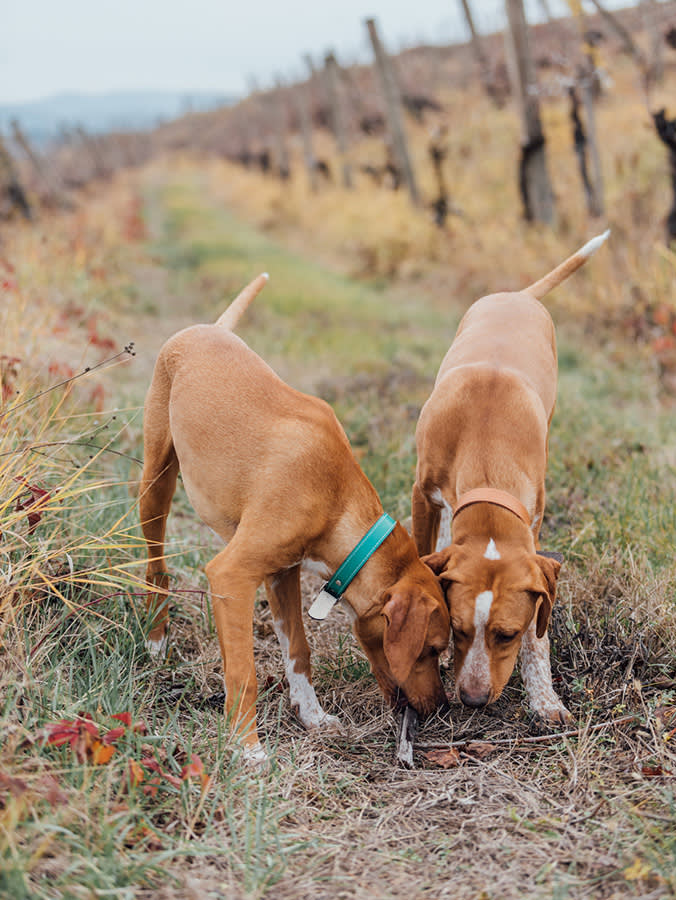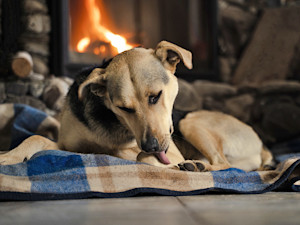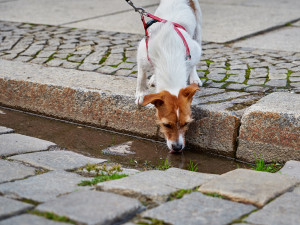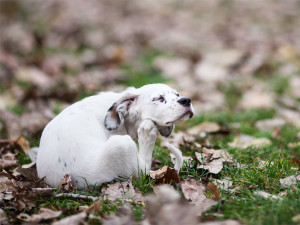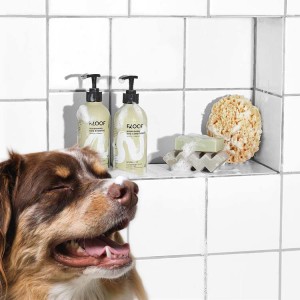A Guide to Ringworm in Dogs
Ringworm isn’t fun for anyone, but it is treatable—and preventable.
In This Article:
What Is Ringworm in Dogs? Causes of Ringworm in Dogs How Do Vets Diagnose Ringworm in Dogs? What Are the Treatment Options for Ringworm in Dogs? How Do You Prevent Ringworm in Dogs? When Should You See A Vet for Ringworm Symptoms? Frequently Asked Questions
Ringworm isn’t what it sounds like. It’s not a worm at all. It’s a fungal infection of the skin that can infect dogs, as well as many other species, including humans. It is transmitted via fungal spores from one animal to another. It can even be transmitted to toys, blankets, or other surfaces.
In most cases, a dog will show signs of the infection within one to three weeks of exposure. It gets its name from the circular appearance of patchy hair loss with crusty or scabby spots on the skin. If you see areas on your dog that fit that description, you should immediately see your vet. Many other skin conditions can look like ringworm, so confirming the diagnosis with your vet before trying treatments is essential. In this guide, we’ll walk you through everything you need to know about ringworm in dogs, including symptoms, causes, treatment options, and prevention strategies.
Save on the litter with color-changing tech that helps you better care for your cat.
What is ringworm in dogs?
To reiterate, ringworm has nothing to do with worms. It is a fungal infection caused by a group of fungi known as dermatophytes. Ringworm gets its name from the circular-shaped lesions it often causes; however, not all cases present this way. Signs can be entirely different; for this reason, the condition is often mistaken for other skin conditions, such as allergies or mange.
Symptoms of ringworm in dogs
Ringworm can take on varied appearancesopens in new tab in different dogs, so diagnosing it based on looks alone can be tricky. Some of the more common signs include circular areas of hair loss, scaling, crusting, or scabbing of the skin, and/or redness. These changes in the skin are typically focused on the face, limbs, and tail but can occur anywhere on the body. Dogs with ringworm can occasionally be itchy, but most dogs do not seem bothered by it. Some cases of ringworm can also affect the nails, creating brittle and crumbly toenails.
Some dogs, especially those with strong immune systems, may carry the fungus without showing obvious symptoms. These asymptomatic carriers can still spread the infection to other animals or people.
Causes of ringworm in dogs
1. Microsporum canis (M. canis): The most common culprit
This dermatophyte is typically found in cats, but can infect dogs, too, and is easily transmitted between animals and people. When you see M. canis, you often see the classic circular patches of hair loss, scaling, and redness. It is very contagious and can live in the environment for months. Approximately 50 percent of M. canis infections will appear positive under a Wood’s lamp. The zoonotic risk is very high. This species is easily transmitted from pets to people.
2. Microsporum gypseum (M. gypseum): Soil-based fungus
M. gypsum is found quite commonly in soil, especially in areas where it is warm and humid. Dogs frequently get infected from rolling in the dirt. It’s more common in dogs that spend a lot of time outdoors. Skin reactions are more inflammatory than those of M. canis. It does not glow under a Wood’s lamp. It can spread to people, but not as easily as M. canis.
3. Trichophyton mentagrophytes (T. mentagrophytes): Rodent-associated fungus
This fungus is quite often associated with wild mice and rice. Dogs may be exposed in barns and sheds. This strain can cause deeper, more inflamed lesions. It can be transmitted to people but not as easily as the other two. T. mentagrophytes can be more challenging to treat and often require a more extended treatment period.
All three fungi are dermatophytes. What does that mean?
Dermatophytes are a special group of fungi that feed on keratin, the fibrous protein in skin, hair, and nails.
They don’t invade deeper tissues but thrive in superficial layers, where keratin is abundant.
The infection causes inflammation, hair loss, scaling, and sometimes itchiness.
Dermatophytes reproduce by forming spores, which are extremely hardy and can persist in the environment for long periods, making disinfection crucial.
Ringworm is very contagious and can easily be transmitted to other dogs, cats, or humans. It can spread through direct contact or grooming tools, bedding, toys, or furniture. Spores can survive in the environment for a very long time (months), so that’s another way a dog can get it.
Puppies, seniors, and dogs with compromised immune systems are more likely to be infected. Crowded or unsanitary environments — such as shelters, kennels, or doggy daycares — can also increase the risk.
How do vets diagnose ringworm in dogs?
Because the symptoms of ringworm can resemble other skin issues, proper diagnosis is essential. Veterinarians use several methods to confirm a ringworm infection:
Wood's Lamp examination: Some strains of ringworm fluoresce under ultraviolet light, revealing a greenish glow. However, not all fungal strains glow, so this method isn’t foolproof.
Microscopic examination: A hair or skin scraping sample may be examined under a microscope for fungal spores.
Fungal culture: This is the most reliable method. The vet collects samples and incubates them on a special medium to see if the fungus grows. Results typically take seven to fourteen days.
PCR testing: Some clinics offer polymerase chain reaction (PCR) testing, which detects fungal DNA. It’s fast and highly accurate but may not be widely available.
Early diagnosis is key to preventing the spread of the infection to other animals and humans.
What are the treatment options for ringworm in dogs?
Treating ringworm can be a three-step process, depending on the severity of the condition. It can include topical treatments, oral medications, and environmental cleaning. Your vet will evaluate your pet’s condition and health and make a treatment plan for the ringworm problem.
Topical treatments
Topical treatments can include shampoos, creams, ointments, and dips. These products are often the first line of defense and are suitable for mild cases of ringworm.
Medicated shampoos often contain miconazole or chlorhexidine and are used several times weekly.
Topicals creams or sprays: These treatments are applied directly to the affected areas, especially small areas. In mild cases, shampoos and topical treatments may be all that is needed.
Oral antifungal medications
Oral medication may be needed for more serious cases of ringworm. The topical treatments are usually still used, but antifungal drugs are added. Commonly prescribed options include:
Griseofulvin
Itraconazole
Terbinafine
These medications must be administered for several weeks, sometimes even months, to eliminate the infection.
Environmental decontamination
Since ringworm spores can persist in the environment for months, thorough cleaning is critical to prevent reinfection. This includes:
Wash all pet bedding, blankets, and toys in hot water.
Vacuuming carpets and upholstery regularly.
Disinfecting surfaces with a solution of diluted bleach (1:10 ratio).
How do you prevent your dog from getting ringworm?
Prevention isn’t always possible, but you can take steps to make the chance of exposure less likely. You should practice strict prevention if you have a puppy, an elderly dog, or multiple pets. Here are some practical steps to reduce exposure and spread:
Keep your house clean. As we have said, spores can last in the environment for a very long time.
Vacuuming, disinfecting hard surfaces, and laundering pet bedding can make a big difference.
Use pet-safe disinfectants and pay special attention to areas where your dog sleeps or spends a lot of time.
Keep a close eye on your pup. Check your dog’s skin regularly, especially if you notice excessive scratching.
Also, look for hair loss, dry patches, or skin changes. If you notice any of these symptoms, see your vet right away.
Also, keep your dog away from any other pet you know with ringworm.
When should you see a vet for ringworm symptoms?
If you notice circular patches of hair loss, scaly skin, or suspicious lesions on your dog, scheduling a veterinary appointment is a good idea. Early treatment can prevent the infection from spreading to other pets or you.
You should definitely see a vet if:
Your dog is losing hair in patches.
There’s redness, swelling, or oozing lesions.
The condition isn’t improving with basic care.
Other pets or family members show signs of infection.
Prompt veterinary care can help identify the problem quickly and start your dog on the path to recovery.
Bottom line
Ringworm has nothing to do with a worm, but is a fungal infection. It is very contagious and your dog can easily catch it from other animals or surfaces. The best way to diagnose it is with a fungal culture. There are three ways to treat it, depending on the severity. Prevention is best accomplished by keeping your dog away from other animals with ringworm.
FAQs
How contagious is ringworm from a dog to a human?
Ringworm is a zoonotic disease that can spread from animals to humans. Children, the elderly, and individuals with weakened immune systems are especially at risk. If your dog has ringworm, avoid cuddling or allowing them on your furniture until treatment has begun and your vet confirms they’re no longer contagious.
Always wash your hands after touching your dog, clean shared surfaces regularly, and wear gloves when applying medicated creams or cleaning infected areas.
Will ringworm go away on its own?
Ringworm might eventually resolve without treatment in mild cases and in dogs with robust immune systems. However, this process can take months, and your dog will remain contagious during that time. Additionally, the infection can worsen or spread to other pets and humans in your household.
Veterinary treatment is strongly recommended to eliminate the infection quickly and safely.
Are there home remedies that can treat ringworm?
While the internet is full of home remedy suggestions — like apple cider vinegar, coconut oil, or tea tree oil — these approaches are unreliable and can even be harmful. Tea tree oil, for example, is toxic to dogs if ingested or absorbed in large quantities.
If you suspect your dog has ringworm, it’s best to consult your veterinarian before trying any DIY treatments. Professional antifungal medications are much more effective and safer for your pet.
References
Kaplan, W., and M. Sue Ivens. “Observations on the Seasonal Variations in Incidence of Ringworm in Dogs and Cats in the United States.” opens in new tabMedical Mycology, vol. 1, no. 2, Jan. 1962, pp. 91–102, Accessed 10 Dec. 2019.
Smith, John M. B., et al.. “Animals as a Reservoir of Human Ringworm in New Zealand.”opens in new tab Australasian Journal of Dermatology, vol. 10, no. 3, Dec. 1969, pp. 169–182, https://doi.org/10.1111/j.1440-0960.1969.tb01187.x. Accessed 28 Nov. 2020.
Wright, A. I. “Ringworm in Dogs and Catsopens in new tab.”opens in new tab Journal of Small Animal Practice, vol. 30, no. 4, Apr. 1989, pp. 242–249.
